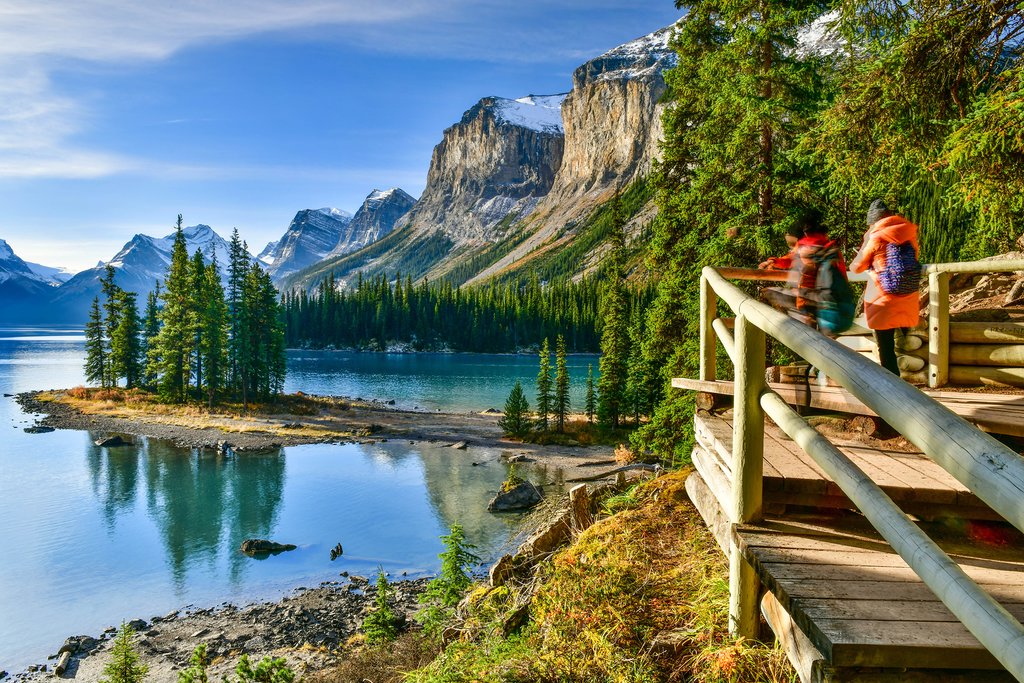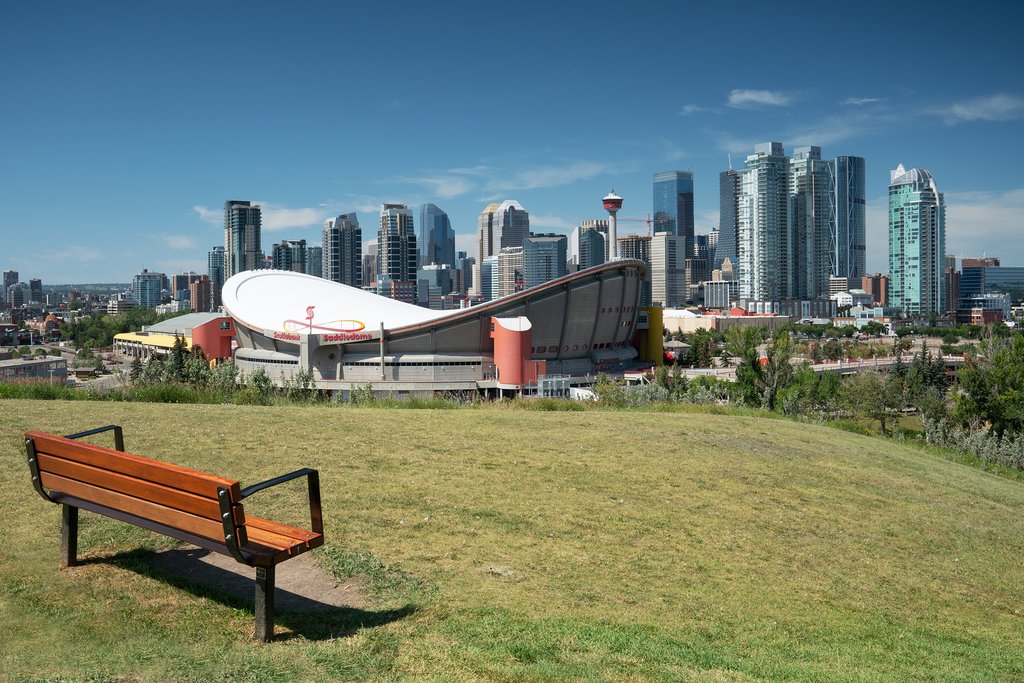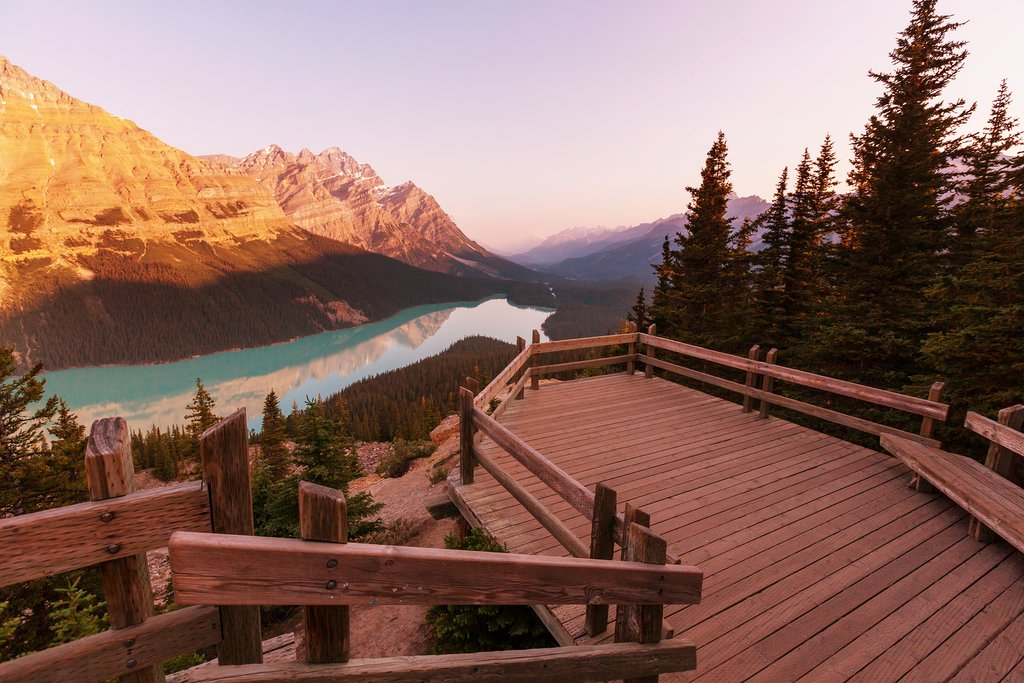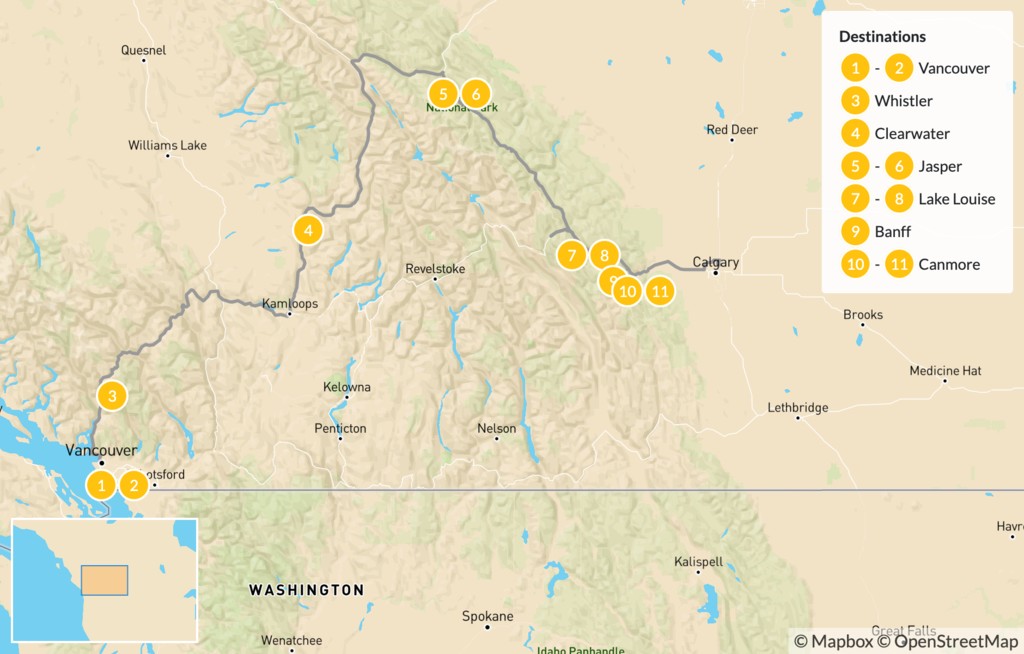Highlights
- Follow the Sea-to-Sky Highway to the alpine resort town of Whistler
- Check out the impressive waterfalls of Wells Gray Provincial Park
- Take a "drive of a lifetime" along the iconic Icefields Parkway
- Hike in Kananaskis Country, a vastly underrated region of the Canadian Rockies
Brief Itinerary
| Day | Highlights | Overnight |
|---|---|---|
| Day 1 | Arrive in Vancouver | Vancouver |
| Day 2 | Explore Vancouver | Vancouver |
| Day 3 | Vancouver to Whistler (2 hours) | Whistler |
| Day 4 | Whistler to Wells Gray (6 hours) | Clearwater |
| Day 5 | Wells Gray Provincial Park to Jasper (3 h 30 min) | Jasper |
| Day 6 | Explore Jasper National Park | Jasper |
| Day 7 | Jasper to Lake Louise (3 hours) | Lake Louise |
| Day 8 | Explore Yoho National Park (from Lake Louise) | Lake Louise |
| Day 9 | Lake Louise to Banff (1 h 15 min) | Banff |
| Day 10 | Banff to Canmore (20 min) | Canmore |
| Day 11 | Explore around Canmore | Canmore |
| Day 12 | Canmore to Calgary, Depart (1 h 30 min) |
Detailed Itinerary
Day 1: Arrive in Vancouver

Fringed by the Pacific Ocean and backed by the coastal mountains, Vancouver is one of the world's most livable cities with some of North America's best cuisine, rich indigenous heritage, and opportunities for outdoor activities.
It takes around 30 minutes to get from the airport to downtown. The city center and surrounding neighborhoods are within easy walking or biking distance and all the main attractions are a short distance away. To get your bearings, start with a stroll along the seawall from English Bay to False Creek before wandering the historical, cobbled streets of Gastown and Chinatown.
With over 60 different cultures, pick from a variety of international restaurants serving anything from Asian cuisine to seasonal farm-to-table dishes. For dinner, choose from a selection of top-notch eateries—from downtown and the West End to the North Shore and Kitsilano. Keep in mind, Vancouverites love eating out any day of the week so be sure to make a reservation if it's a popular restaurant.
Day 2: Explore Vancouver

Explore Vancouver's downtown by foot or rental bike or head to farther-away sights by public bus or Skytrain. In the morning, consider renting a bike and riding around the famous Stanley Park Seawall for great views of the North Shore Mountains and the downtown cityscape.
For lunch, there are a number of great restaurants throughout the city but if the weather is nice, head to Granville Island, a hub of art galleries, studios, unique shops, and the vibrant Granville Island Public Market. After lunch, walk or bike the seawall along False Creek around the recently built-up Olympic Village as a result of the Vancouver Olympics. Alternatively, rent a kayak in Granville Island or False Creek to explore by water.
Day 3: Vancouver to Whistler (2 hours)

Begin your road trip north to Whistler along the Sea-to-Sky Highway (otherwise known as Route 99), one of the country's most iconic drives. A scenic route from sea level to the mountains, there are several beautiful spots worth stopping at during the drive.
Halfway to Whistler—and where the ocean, river, and alpine forest meet—there's Squamish, an access point for outdoor activities and adventure. Just before reaching Squamish, you can see the area's most famous peak from the highway, the Chief, a sheer granite rockface popular with skilled climbers. Pick up the Stawamus Chief Trail for a hike up the back to reach the summit (divided into three peaks and graded as an intermediate hike, it takes the average person 3-4 hours to reach the first—and most visited—summit). Or, take the Sea-to-Sky Gondola up the mountain for excellent views of Howe Sound from Summit Lodge at the top where you can also grab lunch.
You'll reach Whistler, an upscale, chalet-style pedestrian village (and venue for the 2010 Vancouver Winter Olympics) in the early to mid-afternoon. Whistler is North America's largest winter sports resort worth a visit at any time of year. The village is built around Whistler-Blackcomb, twin peaks accessed by an ultramodern lift system that provides opportunities to hike, bike, canoe, kayak, rock climb, or zip-line in warmer months and ski or snowboard in the winter.
Driving time (Vancouver to Whistler): 2 hours (75 miles /120 km)
Day 4: Whistler to Wells Gray (6 hours)

Head northeast, transitioning from the pacific coastal rainforest and mountains to the hot, dry interior of British Columbia's ranch lands. You'll pass through the small towns of Pemberton and Lillooet and cross the mighty Fraser River, entering into the Cariboo region of the province, famous for its gold rush history.
En route, stop at Joffre Lakes Provincial Park to hike to a series of turquoise lakes that are framed by hanging glaciers and mountain peaks. The first (lower) Joffre Lake is a short 5-minute walk from the parking lot and Upper Joffre Lake (6 miles / 10 km, return) takes more effort but is well worth the views (if you have the time).
From Lillooet, continue east along the Gold Nugget Route toward Kamloops, taking in the changing desertlike scene of sagebrush-covered hills and mostly-barren landscape. In Historic Hat Creek, you'll find buildings from gold rush times still standing—some dating as far back as 1861. Experience the western atmosphere as you tour the grounds, and if you're hungry, dine on suitably western dishes, like bison chili, at the Historic Hat Creek Ranch.
Reaching Kamloops, elect to press on or stop to stroll through Kamloops' heritage center, pick up supplies, and do some shopping. From there, head north to Clearwater, the gateway town to Wells Gray Provincial Park which hosts some of the most impressive waterfalls in the province.
If there's time, consider visiting some of the waterfalls. The closest is Spahats Creek Falls, around 10 minutes' drive north of Clearwater. In another 15 minutes, you'll reach Moul Falls, the smallest and most difficult to reach (3 miles / 5 km, around 2 hours return). Helmcken Falls, the most famous in the park, is an hour's drive from Clearwater. Keep your eyes open for wildlife as you drive to the waterfalls, as this road is one of the best spots to catch a glimpse of black bears grazing along the roadside.
Driving time (Whistler to Wells Gray): 6 hours (270 miles / 430 km)
Chat with a local specialist who can help organize your trip.
Day 5: Wells Gray Provincial Park to Jasper (3 h 30 min)

From Clearwater, head east and then head north on Highway 5. It's a beautiful drive to Jasper with the highlight of stopping at Mount Robson Provincial Park en route.
As you pass through Blue River, consider stopping for a wildlife tour to see bears, moose, and eagles or continue on if you want to focus your time at Mount Robson. Once you pass Valemount, you'll catch your first glimpse of Mount Robson's majestic peak at 12,972 ft (3,954 m), the highest peak in the Canadian Rockies.
You can grab lunch and information on the local trails at the Mount Robson Visitor Centre. For a multi-day hiking trip, the Berg Lake Trail offers stunning alpine views and scenic vistas of peaks, lakes, and glaciers. For a day hike, you can walk the first leg of the Berg Lake trail along the Robson River to Kinney Lake (9 miles / 14 km, round trip).
From Mount Robson, it's only an hour's drive to Jasper. This alpine town is situated in the heart of Jasper National Park, set against a backdrop of beautiful mountains. It’s small enough to explore on foot and has a decent selection of restaurants, bars, and shops. It’s mainly used, however, as a gateway for enjoying the nearby outdoor activities—from hiking, canoeing and white water rafting along the Athabasca River to simply enjoying the viewpoints which are accessible by car.
Driving time (Wells Gray to Jasper): 3 hours, 30 minutes (200 miles / 320 km)
Day 6: Explore Jasper National Park

Spend the day exploring Jasper National Park. Twice as vast as its southern neighbor, Banff National Park, this is the largest national park in the Canadian Rockies and home to countless lakes, hiking trails, and a variety of wildlife. Many of the park's main highlights are located within the Maligne Valley, a 15-minute drive northwest of town. Get there early (before 8 am) to beat the crowds, stopping first for a short walk to Maligne Canyon, a 160 ft (50 m) deep gorge carved out by the river over the course of 10,000 years. From there, you can rent a canoe or take a guided cruise on Maligne Lake just before midday before heading back to Jasper.
Other popular highlights the hike to Mount Edith Cavell and the cable car that takes you up Whistlers Mountain for panoramic views of the valley and the surrounding mountains. Keep an eye out for the park's wildlife at all times, as you're likely to see sheep and mountain goats along the valley trails.
You can also check out Miette Hotsprings (a 45-minute drive northwest of Jasper) on the same day depending on how much driving you're willing to do (or save it for another day).
Day 7: Jasper to Lake Louise (3 hours)

Head south along the spectacular Icefields Parkway from Jasper to Lake Louise. You'll leave the forested valley around Jasper and ascend to alpine near the Columbia Icefield. Besides the incredible mountain scenery, keep your eyes out for wildlife along the way—from ptarmigan to bighorn sheep and mountain goats.
Take the entire day to explore this 144-mile (232 km) stretch of highway, stopping at the numerous viewpoints and hitting the hiking trails that veer off into the surrounding wilderness (also a great way to avoid the summer crowds). Expect to arrive in Lake Louise in the early evening.
Day 8: Explore Yoho National Park (from Lake Louise)

Drive 30 minutes west to nearby Yoho National Park. Slightly underrated in comparison to its neighbor, Banff National Park, Yoho is just as beautiful and is one of the best ways to escape the crowds around Lake Louise.
A Cree expression for "awe" and "wonder," start the day early to cover Yoho's highlights as well as to avoid the throngs of travelers. Drive to Emerald Lake and allow 90 minutes to walk the 3-mile (5.2-km) Emerald Lake Loop. Enjoy views of the jewel-hued waters encircled by spruce and firs and the snow-capped Rockies, including the iconic profile of Mount Burgess. Make sure to check out Natural Bridge on your way in or out.
Meanwhile, if it's serious hiking you're after, choose from one or two of over 250 miles (400 km) worth of trails. One of the best hikes in the Rockies is the Iceline Trail, a challenging 13-mile (21-km) roundtrip. It will take you the better part of the day (typically eight hours), but the views alone will supply you the fuel to keep going.
Then there's the wealth of trails that radiate out from picturesque Lake O'Hara with the longest only 4.7 miles (7.5 km). While it's possible to walk to Lake O'Hara (7 miles /11 km), reserve a seat on the Park's Canada shuttle bus (private cars are not allowed on the Lake O'Hara road) to spend more time enjoying the lake and its surroundings. Take the 2-mile (3.2 km) Lake Oesa Trail to climb an elevation of 787 feet (240 m) to overlook the lake. If you're experienced, opt for one of five Alpine routes for a bit of everything: alpine meadows, glaciers, and wooded hillsides.
Day 9: Lake Louise to Banff (1 h 15 min)

Leave Lake Louise behind and head south along the Bow Valley Parkway, an alternate and more scenic route to Banff compared to the faster, Trans-Canada Highway. This 30-mile (50 km) stretch of road between Lake Louise and Banff has a number of great stops, such as Morant's Curve, Castle Junction, and Johnston Canyon. Johnston Canyon is regarded as the highlight and try to arrive early to enjoy the morning light and to avoid the crowds that arrive later in the day.
For your best chances of seeing wildlife, hit the road early in the morning before the traffic builds up throughout the day (it's also beautiful in the morning as the sun lights up the waterfalls en route).
Note: From March 1 to June 25, the stretch between Johnston Canyon Campground and the Fireside Picnic Area of the Bow Valley Parkway is closed between 8 pm and 8 am to provide a safe crossing zone for wildlife.
Driving time (Lake Louise to Banff): 1 hour, 15 minutes (37 miles / 60 km)
Day 10: Banff to Canmore (20 min)

It's a short drive from Banff to Canmore which lies just on the edge of Banff National Park. Canmore used to be a mining town but now serves as a popular back-up location to the busier (and more touristy) town of Banff. Depending on who you ask, Canmore and its surroundings are arguably more beautiful and you'll be closer to Calgary for your onward journey. Canmore is also the gateway to Kananaskis Country—a beautiful region of mountains and lakes in the eastern foothills of the Rockies (yet without the crowds!).
Driving time (Banff to Canmore): 20 minutes (15 miles / 25 km)
Day 11: Explore around Canmore

Located just outside of Banff National Park, Canmore, like everywhere in the Canadian Rockies, is surrounded by incredible scenery and serves as a great base for exploring the outdoors—but without as many crowds as Banff. Downtown, you'll find souvenir shops, galleries, breweries, outdoor stores and a number of great restaurants. There's also a Mountain Market held every Thursday in summer where you can pick up local produce and artisan products.
To explore the area, consider renting a bike and cycling the mostly flat Legacy Trail (16 miles / 26 km) between Canmore and Banff for breathtaking views of the Three Sisters and Vermillion Lakes. (Returning from Banff, you can take the Roam transit bus if you don't want to cycle back.)
Canmore is also the closest town for heading off into Kananaskis Country, a park system encompassing the eastern foothills of the Canadian Rockies—a hidden, lesser-known gem containing numerous beautiful hikes and vantage points but without the crowds of the national park.
As far as options go, Ha Ling Peak is a popular hike that takes around 2-3 hours to get up and one hour to get back down. For a longer hike, check out Rawson Lake and Sarrail Ridge, a moderate 7-mile (11 km) hike near the eastern tip of Upper Kananaskis Lake (around 5 hours return). If you're keen to see wildlife, head to Engadine Lodge and Moose Meadows (a one-hour drive down the Spray Lakes/Smith Dorien trail from Canmore). It's a nice spot for an afternoon tea surrounded by beautiful meadows which are one fo the best spots in the Canadian Rockies to spot wildlife.
You can also check out the Yamnuska Wolfdog Sanctuary, a non-profit organization that rehabilitates and houses wolfdogs (part wolf, part dog) from all over North America. They run educational tours that take you through their habitat and raise awareness about this type of breed.
Day 12: Canmore to Calgary, Depart (1 h 30 min)

From Canmore, it's a short drive to Calgary's international airport. Be sure to leave ample time in case of traffic and to drop off your rental vehicle. En route look for signage leading you to the airport.
Driving time (Canmore to Calgary International Airport): 1 hour, 30 minutes (75 miles / 120 km)


